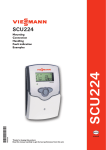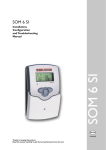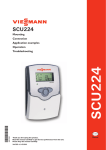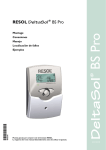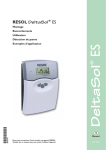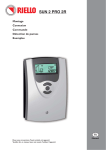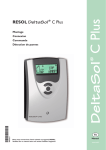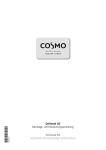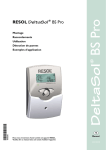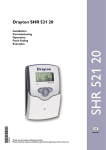Download SOM 7 SI Solar Controller Installation Manual
Transcript
SOM 7 SI 49004470 SOM 7 SI *49004470* Installation, Configuration and Troubleshooting Manual Thanks for buying this product. Read this manual carefully to get the best perfomance from this unit. manual SOM 7 SI Contents Imprint Safety regulations ................................................................2 Technical data and overview of functions ........................3 1. Installation .............................................................4 1.1 Mounting .................................................................................. 4 1.2 Electrical Connection ........................................................... 4 1.2.1 Data communication / Bus ............................................. 5 1.2.2 Standard Solar System .......................................................... 5 1.2.3 Solar System with Heat Exchange ..................................... 6 1.2.4 Solar System with After-Heating ........................................ 6 1.2.5 Solar System with Layered Tank Charge........................... 7 1.2.6 2 Tank Solar System with Valve Logic ................................ 7 1.2.7 2 Tank Solar System with Pump Logic ............................... 8 1.2.8 Solar System with East-West Collectors ......................... 8 1.2.9 Solar System with After-Heating by Solid Fuel Boiler ... 9 1.2.10 Solar system with heating circuit return flow incr.......... 9 2. Opearation and function ....................................10 2.1 2.2 2.2.1 2.2.2 2.2.3 2.3 2.3.1 2.3.2 3. 4. 4.1 4.1.1-6 4.1.6-21 4.2 5. 6. Safety regulations: Please read the following information carefully before installing and operating the controller.When configuring the controller please change the default settings as illustrated in section 4.2. This will avoid damage to the solar system by common problems such as overheating. Installing the controller using the default settings without making any adjustments to the configuration parameters is likely to result in an overheating condition of the solar system at some point. Please also note that changing the system scheme (Arr 1 - 9) will reset all settings to the defaults. Please ensure that the mounting is in accordance to local, state and federal regulations. Reprinting / copying This installation manual in its entirety is copyrighted. Another use outside the copyright requires the approval of STIEBEL-ELTRON Inc. This especially applies for copies, translations, micro films and the storage into electronic systems. Editor: STIEBEL-ELTRON Inc. Adjustment buttons ............................................................ 10 System monitoring display ................................................. 10 Channel indication ............................................................... 10 Tool bar .................................................................................. 10 System screen ....................................................................... 11 Blinking codes ....................................................................... 11 System-Screen Blinking codes........................................... 11 LED blinking codes .............................................................. 11 Primary commissioning......................................12 Control parameter and display channels ..........13 Channel overview ................................................................ 13 Indication channels .............................................................. 15 Adjustment channels ........................................................... 16 Recommended Settings .....................................21 Troubleshooting Tips ...........................................23 Warranty..............................................................28 Important notice: Your own calculations and plans under consideration of the current norms and DIN-directions should primarily be basis for your projects. We don´t offer a guarantee for the completeness of the drawings and texts of this manual - they only represent some examples. They can only be used at your own risk. No liability is assumed for incorrect, incomplete or false information and the resulting damages. . CU 72060171 01 UL 60730-1A:2002 CSA E60730.1:2002 US © 08042 som_7_si.monen.indd C |2 SOM 7 SI • System Monitoring Display • Up to 4 Temperature Sensors, Pt1000 • 9 Selectable System Schemes • Energy Production Measurement • VBus® • Function Control • Thermostat Function with Time Control • Service Center Software Connectivity • User-Friendly Operation ! • Compact, Easy to Install Housing Scope of delivery: 1 x SOM 7 SI 1 x accessory bag 1 x spare fuse T4A 2 x screws and dowels 4 x strain relief and screws © 08042 som_7_si.monen.indd Additionally enclosed in the full kit: 4 x sensor FKP6 Technical data Housing: plastic, PC-ABS and PMMA Protection type: IP 20 / DIN 40050 Ambient temp.: 32 ... 104 °F Size: 172 x 110 x 46 mm Mounting: wall mounting, mounting into patch-panels is possible Display: System screen for system visualisation, 16-segment display, 7-segment display, 8 symbols for system status and operating control lamp Operation: by 3 pushbuttons in the front of the housing Functions: Differential temperature controller with optional add-on system functions. Function control according to BAW-standards, operating hours counter for solar pump, tube collector special function, thermostat function and heat quantity balancing. Inputs: for 4 temperature sensors Pt1000 Outputs: 2 electromechanical relays Bus: VBus® Power supply: 120 VAC Total power supply: 4 (2) A 120VAC 3| SOM 7 SI 1. Installation 1.1 Mounting Warning! Switch-off power supply before opening the housing. display pushbutton cover cable conduits with strain relief can fuse 4A fastening The unit is designed for indoor installation only. It is not suitable for installation in hazardous locations and should not be sited near to any electromagnetic field. The controller must installed in accordance with all electrical regulations. These regulations vary from region to region. Please contact the appropriate agency in your area if unclear on this. Wall Mounting Instructions 1. Unscrew the cross-recessed screw of the cover and remove it from the housing. 2. Mark the upper fastening point on the wall and mount the enclosed dowel and screw. 3. Hang up the housing at the upper fastening point and mark the lower fastening point on the wall. The distance between the 2 mounting holes is 130 mm. 4. Fasten the housing at its lower point.. 1.2 Electrical connection fuse T4A DE - 45527 Hattingen DeltaSol BS Plus 115 V~ CU 72060171 01 UL 60730-1A:2002 CSA E60730.1:2002 Temp. Sensor Pt1000 S1 1 2 3 S2 4 S3 5 6 S4 7 8 VBus 9 10 R1 2 (1) A 115 V~ R2 2 (1) A 115 V~ 12 13 14 N R2 N R1 N L 15 16 17 18 19 20 VBus® Sensor clamp ground clamp consumer clamps net clamps Dangerous voltage on contact! Electrostatic discharge can lead to damages of electronic components! |4 The power supply to the controller must only be made by an external power supply switch and the line voltage must be 120 VAC (50/60 Hz). Flexible lines are to be fixed at the housing by enclosed strain relief supports and screws. The controller is equipped with 2 standard relays, to which the consumers (pumps, valves etc.) can be connected: • Relay 1 18 = conductor R1 17 = neutral conductor N 13 = ground clamp • Relay 2 16 = conductor R2 15 = neutral conductor N 14 = ground clamp The temperature sensors (S1 up to S4) will be connected to the following terminals independently of the polarity: 1 / 2 = Sensor 1 (e.g. Sensor collector 1) 3 / 4 = Sensor 2 (e.g. Sensor tank 1) 5 / 6 = Sensor 3 (e.g. Sensor collector 2) 7 / 8 = Sensor 4 (e.g. Sensor tank 2) The power supply is effected to the clamps: 19 = Neutral Conductor N 20 = Line Conductor L 12 = Ground Clamp © 08042 som_7_si.monen.indd fixing SOM 7 SI 1.2.1 Data communication/ Bus DE - 45527 Hattingen DeltaSol BS Plus CU 72060171 01 UL 60730-1A:2002 CSA E60730.1:2002 Temp. Sensor Pt1000 S1 1 2 3 S2 4 S3 5 6 S4 7 8 VBus 9 10 12 13 14 T4A 115 V~ R1 2 (1) A 115 V~ R2 2 (1) A 115 V~ The controller comes with a VBus® for data communication and energy supply of external modules. The connection is effected with optional polarity at the clamps marked with„VBus®. Via this data bus you can install one or more VBus® modules. N R2 N R1 N L 15 16 17 18 19 20 • Energy Production Measurement Module WMZ-M1 VBus connection clamps • Large Display GA3 • Data Logger, DL1 • Data Teleindication, DFA2 The controller can also be connected to a PC with the help of a RS-COM adapter. With the Service Center Software (RCS) the controller parameters can be changed, measurements can be read out, processed and visualised. The software enables an easy function control and adjustment of the system. 1.2.2 Allocation of Clamps for System 1 Standard Solar System with 1 tank, 1 pump and 2 sensors. Sensor S4 / TRF can optionally be used for Energy Production Measurement. Arr 1 S1 R1 © 08042 som_7_si.monen.indd S3 S4 / TRF S2 Symbol S1 S2 S3 S4 / TRF R1 Specification Collector Sensor Lower Tank Sensor Upper Tank Sensor (optional) Sensor for Energy Production Measurement (optional) Solar Pump 5| SOM 7 SI 1.2.3 Allocation of Clamps for System 2 Solar System with Heat Exchange with an existing tank. With 1 tank, 4 sensors and 2 pumps. Arr 2 S1 R1 S3 Tank 1 Tank 2 S4 S2 R2 1.2.4 Allocation of Clamps for System 3 Symbol S1 S2 S3 S4 R1 R2 Specification Collector Sensor Lower Tank Sensor Upper Tank Sensor Tank 2 Sensor Solar Pump Pump for Heat Exchange Solar System with After-Heating with 1 tank, 3 sensors and after-heating thermostatic control options. Sensor S4/TRF can optionally be used for Energy Production Measurement. Arr 3 R1 S4 / TRF S3 S2 R2 Symbol S1 S2 S3 S4 / TRF R1 |6 Specification Collector Sensor Lower Tank Sensor Upper Tank Sensor Sensor for Energy Production Measurement (Optional) Solar Pump © 08042 som_7_si.monen.indd S1 SOM 7 SI Solar System with Layered Tank Charge with 1 tank, 3 sensors, 1 solar pump and a 3-way-valve for layered tank charge. Sensor S4 / TRF can optionally be used for heat quantity balancing. 1.2.5 Allocation of clamps for system 4 Arr 4 S1 R1 Symbol S1 S2 S3 S4 / TRF S3 R2 S2 S4 / TRF R1 1.2.6 Allocation of clamps for system 5 Specification Collector Sensor Lower Tank Sensor Upper Tank Sensor Sensor for Energy Production Measurement (Optional) Solar Pump 2 Tank Solar System with Valve Logic: with 2 tanks, 3 sensors, 1 solar pump and 1 3-way-valve. Sensor S4/ TRF can optionally be used for Energy Production Measurement Arr 5 S1 R2 R1 Tank 1 Tank 2 © 08042 som_7_si.monen.indd S2 S4 / TRF S3 Symbol S1 S2 S3 S4 / TRF R1 R2 Specification Collector sensor Tank 1 Sensor Tank 2 Sensor Sensor for Energy Production Measurement (optional) Solar Pump 3-Way Valve 7| SOM 7 SI 2 Tank Solar System with Pump Logic with 2 tanks, 3 sensors and 2 solar pumps. 1.2.6 Allocation of Clamps for System 6 Arr 6 S1 S4 Tank 1 R1 Tank 2 S2 R2 S3 Symbol S1 S2 S3 S4 R1 R2 1.2.7Allocation of Clamps for System 7 Specification Collector Sensor Tank Sensor 1 Tank Sensor 2 Measuring Sensor (optinal) Solar Pump 1 Solar Pump 2 Solar System with East-West Collectors, 1 tank, 3 sensors and 2 solar pumps. This system is appropriate for any system with multiple collector banks with differing output power. Arr 7 R1 S3 R2 S2 Symbol S1 S2 S3 S4 R1 R2 |8 Specification Collector Sensor Tank Sensor 1 Collector Sensor 2 Measuring Sensor (optinal) Collector 1 Solar Pump Collector 2 Solar Pump © 08042 som_7_si.monen.indd S1 SOM 7 SI Solar System with After-Heating by Solid Fuel Boiler with 1 tank, 4 sensors, 1 solar pump and 1 pump for afterheating. 1.2.8 Allocation of Clamps for System 8 Arr 8 S1 S4 S3 R1 S2 1.2.9 Allocation of clamps for system 9 Symbol S1 S2 S3 S4 R1 R2 R2 Specification Collector Sensor Lower Tank Sensor Upper Tank Sensor Tank for Solid Fuel Boiler Solar Pump Pump for Solid Fuel Boiler Solar System and Heating Circuit Reverse Raising with 1 tank, 4 sensors, 1 solar pump and 1 3-way-valve for heating circuit reverse raising. Arr 9 S1 R1 S4 S3 © 08042 som_7_si.monen.indd S2 R2 Symbol Specification S1 Collector Sensor S2 Lower Tank Sensor S3 Upper Tank Sensor S4 Heating Circuit Return R1 Solar Pump R2 3-Way-Valve 9| SOM 7 SI 2. Opeartion and function 2.1 Pushbuttons for adjustment backward forward 2 3 1 SET (selection / adjustment mode) 2.2 System monitoring display ! The controller is operated by the 3 keys below the display. To enter the configuration mode toggle through the display parameters by pressing and releasing key 1 until this no longer causes the display to change. At this point press and hold key 1 until the configuration parameters are displayed (about 5 seconds), then quickly release the key to avoid toggling to the end of the parameter list.The first parameter in the list is DT O. To change the setting of a given parameter, follow the steps below. 1. Toggle to the parameter using keys 1 and/or 2. The abbreviation for the parameter is displayed on the right side of the screen, with the setting directly below, and the set icon solid (not blinking) on the extreme right. 2. Press key 3. The set icon begins blinking signifying that the parameter may now be adjusted. 3. Quickly use keys 1 and/or 2 to change the setting to that which is required. 4. Press key 3 again. The set icon stops blinking signifying that the new value has been stored. The system display consists of an indication channel, a tool bar, and the system screen. These are detailed below. Monitoring-Display 2.2.1 Indication Channel The indication channel consists of two lines. The upper line is an alphanumeric 16-segment display, in which an abbreviation of the current setting or reading is shown. In the lower 7-segment display, the value of said reading or setting is shown. Indication channel 2.2.2 Tool bar Toolbar only illustrated above The additional symbols of the tool bar indicate the current system status. Symbol standard blinking relay 1 active relay 2 active antifreeze- function activated collector cooling function or reccoling function active collector minimum limitation or antifreeze function active collector security shutdown or tank securtiy shutdown active + sensor defect + manual operation active an adjustment channel is changed SET-mode | 10 © 08042 som_7_si.monen.indd maximum tank limitation active / maximum tank temperature exceeded SOM 7 SI 2.2.3 System screen The system screen (active system scheme) shows the schemes selected on the controller. It consists of several system component symbols, which are - depending on the current status of the system - either flashing, permanently shown or hidden. System Screen only Sensors upper sensor tank Collector 2 Heating circuit Collector 1 Valve Valve Pumps Sensor Additional symbol for operation of the burner Tank heat-exchanger Tank Tank 2 or afterheating (with an additional symbol) Temperature sensor Collectors with collector sensor Heating circuit Tanks 1 and 2 with heat-exchanger Pump 3-way-valve The flow direction or the current breaking capacity is always shown. Afterheating with burner symbol 2.3 Blinking codes © 08042 som_7_si.monen.indd 2.3.1 System screen blinking codes 2.3.2 LED blinking codes • Pumps are blinking during starting phase • Sensors are blinking when their value is being displayed in the indication channel. • Sensors are quickly blinking in case of sensor defect. • Burner symbol is blinking if after-heating is activated Constantly green: Red/green blinking: Red blinking: Normal operation Power-up phase Manual operation Sensor defect (sensor symbol is quickly blinking) 11 | SOM 7 SI 3.Primary commissioning For primary commissioning the system scheme has to be selected first 1. After AC power is supplied to the unit it goes through its power up tests during which the control lamp is blinking red and green. After this the unit is ready for configuration. The unit‘s default system scheme is Arr. 1. operating control lamp forward backward 2 3 1 2. Clock time adjustment in channel TIME. By pressing the button once you can adjust hours, pressing it once again the minutes.The time can be adjusted by buttons 1 and 2 and saved by pressing the button. 3. - select adjustment channel Arr - change into -mode (see 2.1) - adjustment are saved by pressing button Now the controller is ready for operation and should enable an optimum operation of the solar system with the factory settings. SET (selection / adjustment mode) Arr 1 Arr 2 Arr 3 Arr 4 Arr 5 Arr 6 Arr 7 Arr 8 System survey: Arr 1 : Arr 2 : Arr 3 : Arr 4 : Arr 5 : Arr 6 : Arr 7 : Arr 8 : Arr 9 : Standard Solar System Solar System with Heat Exchange Solar System with After-Heating Solar System with Tank Charge in Layers 2-Tank Solar System with Valve Logic 2-Tank Solar System with Pump Logic Solar System with 2 Collectors and 1 Tank Solar System with After-Heating by Solid Hot Fuel Boiler Solar System with Heating Circuit Reverse Raising © 08042 som_7_si.monen.indd Arr 9 | 12 SOM 7 SI 4. Control parameter and indication channels 4.1 Channel-overview Corresponding channel is only available if the option Energy Production Measurement is activated (OHQM). Legend: x Corresponding channel is available. x* Corresponding channel is available if the appropriate option is activated. COL COL 1 TST TSTU TST1 TSTO TST2 TFSB TRET COL2 S3 TRF S4 hP h P1 h P2 kWh MWh time Arr DT O DT1O DT F DT1F 2 x 3 x 4 x Arr 5 x 6 x 7 8 x 9 x x x x x x x x x x x x x x x x x x x x x x x x x x x x x x x x x x x x x x x x x x x x x x x x x x x x x x x x x x x 1-9 x x x x x x x x x x x x x x x x x x x x x x x x x x Specification Page Temperature collector 1 Temperature collector 1 Temperature tank 1 Temperature tank 1 below Temperature tank 1 below Temperature tank 1 at the top Temperature tank 2 below Temperature solid hot fuel boiler Temperature heating circuit Temperature collector 2 Temperature sensor 3 Temperature return sensor Temperature sensor 4 Operating hours relay 1 Operating hours relay 1 Operating hours relay 2 Heat quantity kWh Heat quantity MWh Time System Switch-on temperature diff Switch-on temperature diff 1 Switch-off temperature diff 1 Switch-off temperature difference 15 15 15 15 15 15 15 15 15 15 15 15 15 16 16 16 16 16 15 12 17 17 17 17 Maximum temperature tank 1 Maximum temperature tank 1 Switch-on temperature difference 2 Switch-off temperature difference 2 Maximum temperature tank 2 emergency temperature collector 1 emergency temperature collector 1 17 17 17 17 17 18 18 © 08042 som_7_si.monen.indd S MX S1 MX DT2O DT2F S2MX EM EM1 1 x MEDT The channel antifreeze content (MED%) is only shown if the antifreeze is not water or Tyfocor LS / G-LS (MEDT 0 or 3). Adjustments concerning the antifreeze content will only make sense if the antifreeze is used in the solar circuit. Please note: S3 and S4 are only indicated in case of sensors connected Channnel Corresponding channel is only available if the option Energy Production Measurement is deactivated (OHQM). 13 | SOM 7 SI Channel OCX OCX1 CMX CMX1 OKN OKN1 CMN CMN1 OCF OCF1 CFR CFR1 EM2 OCX2 KMX2 OCN2 CMN2 OCF2 CFR2 PRIO tST tRUN OREC O TC DT3O DT3F MX3O MX3F MN3O MN3F AH O AH F OHQM FMAX MEDT MED% t1 on t1 off t2 on t2 off t3 on t3 off HND1 HND2 LANG UNIT PROG 2 x 3 x 4 x Arr 5 x 6 x 7 8 x 9 x x* x* x x x* x* x x x* x* x x* x* x* x* x* x* x* x x x x x x x x* x* x* x* x* x* x* x x x x x x x x* x* x* x* x* x* x* x x x* x x* x x* x x x x x x x x x x x MEDT x x x x x x x x x x x x x MEDT x x x x x x x x x x x x x x x x x x x x x MEDT x MEDT x x x x x x x x XX.XX X.XX x x x x x x x x x x x x x x x x x x x x x x x x x x x x x x x x x Specification option collector cooling collector 1 option collector cooling collector 1 maximum temperature collector 1 maximum temperature collector 1 option minimum limitation collector 1 option minimum limitation collector 1 minimun temperature collector 1 minimun temperature collector 1 option antifreeze collector 1 option antifreeze collector 1 antifreeze temperature collector 1 antifreeze temperature collector 1 emergency temperature collector 2 option collector cooling collector 2 maximum temperature collector 2 option miminum limitation collector 2 minium temperature collector 2 option antifreeze collector 2 antifreeze temperature collector 2 priority stop time Ciruclation time option reccoling option tube collector switch-on temperature difference 3 switch-off temperature difference 3 switch-on treshold for maximum temp. switch-off treshold for maximum temp. switch-on treshold for minimum temp. switch-off treshold for minimum temp. switch-on temp. for thermostat 1 switch-off temp. for thermostat 1 option WMZ maximum flow antifreeze type antifreeze content Switch on time 1 thermostat Switch off time 1 thermostat Switch on time 2 thermostat Switch off time 2 thermostat Switch on time 3 thermostat Switch off time 3 thermostat manual operation relay 1 manual operation relay 2 Language Change over °FAH / °CEL program number Page 18 18 18 18 18 18 18 18 18 18 18 18 18 18 18 18 18 18 18 19 19 19 19 19 17 17 17 17 17 17 20 20 16 16 16 16 20 20 20 20 20 20 20 20 20 20 version number © 08042 som_7_si.monen.indd VERS 1 x | 14 SOM 7 SI 4.1.1 Collector Temperatures COL, COL1, COL2: Collector Temperature display range: -40 → +480°F Shows the current collector temperature. • COL : collector temperature (1-collector-system) • COL1: collector 1 temperature • COL2: collector 2 temperature 4.1.2 Tank Temperatures TST,TSTL,TSTU, TST1,TST2: Tank Temperatures Display range: -40 →+480 °F Shows the current tank temperature. • • • • • TST : tank temperature (1-tank-system) TSTL : tank temperature, lower TSTU: tank temperature, upper TST1 : tank 1 temperature TST2 : tank 2 temperature 4.1.3 Sensor 3 and Sensor 4 Temperatures S3, S4: S3, S4: Sensor Temperatures Display range: -40 →+480 °F Shows the current temperature of the corresponding additional sensor (without control function). • S3 : sensor 3 temperature • S4 : sensor 4 temperature Please note: S3 and S4 are only shown if the temperature sensors are connected. 4.1.4 Other Temperatures TFSB,TRET,TRF: Other M e a s u r e d Temperatures Display range: -40 →+480 °F Shows the current temperature of the corresponding sensor. • TFSB : solid fuel boiler temperature • TRET: heating reverse raising temperature • TRF : return flow temperature 4.1.5 Time © 08042 som_7_si.monen.indd This channel stores and displays the current time in 24 hour format. To change the stored time, press the key 3 for 2 seconds. This causes the icon to blink and the hour may be adjusted using keys 1 and 2. To adjust the minutes press key 3 again. The icon continues to blink, but keys 1 and 2 now cause the minutes to change. Pressing key 3 again causes the displayed value to be stored. 15 | SOM 7 SI 4.1.6Operating hours counter h P / h P1 / h P2: Operating Hours Counter Indication channel The operating hours counter adds up the solar operating hours of the respective relay (h P / h P1 / hP2). The total amount of hours which the relay has been active is shown on the display. The operating hours total can be reset. As soon as the operating hours channel is selected, the symbol is displayed solid.To reset the operating hours press and hold the middle key (key 3) for approximately 5 seconds. The set symbol blinks. Press key 3 again and the operating hours counter is reset to 0. In order to interrupt the RESET-procedure, don’t press any button for about 5 seconds. The controller returns automatically into the display mode. 4.1.7Energy Production Measurement OHQM: Energy Production Measurement. Adjustment range: OFF/ON Factory setting: OFF FMAX: Volumetric flow rate in l/min Adjustment range 0 - 20 in steps of 0.1 Factory setting 6.0 MEDT: Type of antifreeze Adjustment range 0 - 3 Factory setting 1 MED%: Concentration of antifreeze in (Vol-) % MED% is blinded out by MEDT 0 and 3. Adjustment range 20 - 70 Factory setting 45 kWh/MWh:Energy production in kWh / MWh Display channel A measurement of the system’s energy production is possible in conjunction with a flowmeter and an additional sensor which measures the heat exchanger’s return temperature. Activate this option by changing the value of OHQM to “on”. Adjust this setting to the maximum flow rate of the system in liters per minute. This is necessary in order to calculate the system‘s actual energy output. Some controllers have an additional parameter, FMXG, which is the flow rate in gallons per minute. Type of antifreeze: 0 :water 1 :propylene glycol 2 :ethylene glycol 3 :Tyfocor® LS / G-LS The energy produced by the system is measured by the calculation of the volume of heat exchanger fluid moved through the system and a comparison of the temperature of the fluid leaving the collector (S1) with that of the fluid exiting the storage tank‘s heat exchanger (S4). It is shown in kWh in one channel and MWh in another. In order to interrupt the RESET-procedure, no button should be pressed for about 5 seconds. The controller returns automatically into indication mode. | 16 © 08042 som_7_si.monen.indd The total energy produced can be reset. As soon as one of the display channels of the heat quantity is selected, the symbol is displayed solid.To reset the total energy produced press and hold the middle key (key 3) for approximately 5 seconds. The set symbol blinks. Press key 3 again and the total energy produced is reset to 0.. SOM 7 SI 4.1.8 ∆T-regulation DT O / DT1O / DT2O / DT3O: Switch-on temperature differential Adjustment range 2.0 - 40.0 °F Factory setting 12.0 Primarily the controller works in the same way as a standard differential controller. If the switch-on difference (DT O/ DT1O/DT2O/DT3O) is sensed, the pump is activated. If the adjusted switch-off temperature is measured (DTF/ DT1F/DT2F/DT3F), the controller switches-off. DT F / DT1F / DT2F / DT3F: Switch-off temperature differential Adjustment range 1.0 - 38.0 °F Factory setting 8.0 °F Please note: Switch-on temperature difference DT O must be at least 2 °F higher than the switch-off temperature difference DT F. 4.1.9 Maximum Tank Temperature S MX / S1MX / S2MX: Maximum storage tank temp. Adjustment range: 40 - 205 °F Factory setting 140 °F © 08042 som_7_si.monen.indd 4.1.10 ∆T-controller (solid fuel boiler and heat exchange) Maximum Temperature Limitation MX3O / MX3F: Maximum temperature limitation Adjustment range MX3O 137 - 205°F MX3F 30 - 136°F Factory settings MX3O 140°F MX3F 136°F Minimum Temperature Limitation MN3O / MN3F: Minimum Temperature Limitation Adjustment range Arr 2 MN3O 30 - 49°F MN3F 41 - 195°F Arr 8 MN3O 30 - 149°F MN3F 141 - 195°F Factory settings Arr 2 MN3O 40°F | MN3F 50°F Arr 8 MN3O 140°F | MN3F 150°F If the adjusted maximum temperature is exceeded, a further loading of the store is stopped so that a damaging overheating can be avoided. If the maximum store temperature is exceeded, the symbol is displayed. Please note: The controller is equipped with a securityswitch-off of the storage tank, which will not allow further loading of the tank if it reaches 205 °F. The Maximum Temperature Limitation regulates the temperatures at which the second differential switch-on temperature (DT3O) will operate. This feature is only available if Arr 2 or Arr 8 is selected (for solid fuel boilers or heat exchange regulation). If the relavent sensor measures a temperature greater than MX3O, relay 2 is disabled. Relay 2 will not be enabled again until a temperature less than MX3F is reached. Reference sensor: S3 by Arr 8 (TSTU) S4 by Arr 2 (TST2) The Minimum Temperature Limitation also works in conjunction with the second differential switch-on temperature (DT3O). If the relavent sensor measures a temperature less than MN3O, relay 2 will be disabled. Relay 2 will not be enabled again until a temperature greater than MN3F is measured. by the relavent sensor. Reference sensor: S4 by Arr 8 (TFSB) S3 by Arr 2 (TSTU) 17 | SOM 7 SI 4.1.11 Collector Emergency Shutdown Temperature EM / EM1 / EM2: Collector Emergency Shutdown Temperature Adjustment range 230 - 400 °F, Factory setting 285 °F If the collector emergency shutdown temperature (EM/ EM1/EM2) is reached, the solar pump (R1/R2) is deactivated in order to avoid damaging the solar components.The default setting is 285°F. If the system is in emergency shutdown mode the symbol is flashing.The system will not exit this mode until the temperature measured is 30°F lower than the value of this setting. 4.1.12System Cooling Functions. OCX / OCX1 / OCX2: System Cooling Adjustment range OFF/ON Factory setting OFF CMX / CMX1 / CMX2: Maximum Collector Temperature Adjustment range: 210 - 380 °F Factory setting 250 °F The system cooling function is used to prevent the system‘s heat exchanger fluid from overheating.This in turn prevents the degradation of the fluid‘s corrosion inhibitors avoiding damage to the system components. If the system cooling function is activated the symbol is flashing. If the maximum collector temperature (CMX/CMX1/ CMX2) is reached the maximum storage tank temperature (S MX/S1MX/S2MX) is overridden and the system‘s circulator pump is turned on, cooling the system‘s HX fluid using the water in the storage tank. This will continue until either the collector temperature is measured to be at least 9°F lower than the setting of “CMX/CMX1/CMX2”, the tank reaches it’s 205°F security-switch-off temperature, or the collector reaches its collector emergency shutdown temperature.The last two instances should not occur if the system is sized and configured properly. 4.1.13Minimum Collector Temperature Limit CMN / CMN1 / CMN2: Collector Minimum Temperature Adjustment range 50 - 195°F Factory setting 50°F 4.1.14Antifreeze Function OCF / OCF1 / OCF2: Antifreeze Function Adjustment range OFF/ON Factory setting OFF CFR / CFR1 / CFR2: Antifreeze Temperature Adjustment range 15 -50°F Factory setting 40°F | 18 The minimum collector temperature is a temperature which must be exceeded in order for the solar pump (R1/R2) to be switched-on.The minimum temperature setting is used to avoid starting-up the solar pump (or solid fuel boiler charging pumps) when the temperature of the heat exchanger fluid is too low. If the minimum temperature feature is activated the symbol is shown on the display (blinking). The antifreeze function activates the loading circuit between collector and tank if the antifreeze temperature is reached in order to protect the heat exchanger fluid against freezing or “thickening“. If the antifreeze temperature is exceeded by 2°F, the loading circuit will be deactivated. Please note: As there is only a limited heat quantity of the tank available for this function, the antifreeze function should only be used in regions with few days of temperatures around freezing point. © 08042 som_7_si.monen.indd OCN / OCN1 / OCN2: Collector Minimum Temperature Limitation Adjustment range OFF/ON SOM 7 SI 4.1.15 Oscillating Charge Respective Adjustment Values: Factory setting Adjustment range Priority [PRIO] (1 / Arr 5,6) (2 / Arr 4) 0-2 Oscillating Break Time [tST] Oscillating Charge Time [tRUN] 2 min. 15 min. 1-30 min. 1-30 min. SOM 7 SI Priority Logic The above oscillating charge parameters are only available in multi-tank or layered charge systems (Arr 4, 5 and 6). If Tank Priority is set to 0, the tanks which show a temperature difference towards the collector are loaded in numerical order (tank 1 or tank 2). Usually only one tank is loaded at this point. For Arr= 5, 6 parallel loading is also possible. Tank Priority: Oscillating Break Time/Oscillating Charge Time/ Collector Rising Temperature 4.1.16 Recooling function OREC: Recooling Option adjustment range OFF / ON Factory setting: OFF The controller checks the tanks regarding loading facilities (switch-on difference). If the priority tank cannot be loaded, the lower-ranking tank is checked. If the lower-ranking tank can be charged this is effected by the so-called “oscilating charge time” (tRUN).When the oscillating charge time is over the loading is stopped. The controller regulates the increase of the collector temperature. If it increases by the collector rising temperature (∆T-Col 4°F, fixed software value), the expired break time is again reset to zero and the oscillating break time starts again. If the switch-on conditions of the priority tank are not reached, the loading of the lower-ranking tank is continued. If the priority switch has reached its maximum temperature, the oscillating charge is not effected. This setting is designed to be used in conjunction with the System Cooling Function, which overrides the maximum store temperature (S MX, S1MX, S2MX) when used. This function will cool the tank back down to its maximum temperature when the collector temperature becomes low enough to facilitate such. This prevents a cumulative overheating condition if the cooling function needs to be used multiple days in a row. In order to utilize this function with tube collectors, a heat rejection loop (heat dump) is necessary. 4.1.17 Tube collector special function © 08042 som_7_si.monen.indd O TC: Tube Collector Function Adjustment range: OFF / ON Factory setting: OFF If the controller measures an increase of 4 °F compared to the collector temperature which was last stored, the solar pump is switched-on for about 30 seconds. After the solar pump is deactivated the current collector temperature is stored as new reference value. If the measured temperature (new reference value) is again exceeded by 4 °F, the solar pump again switches-on for 30 seconds. If the switch-on differential is reached during any of these processes the controller automatically switches over to solar charging. If the collector temperature drops by 4 °F while the system fluid is stagnant, the switch-on value for the special tube collector function will be recalculated. 19 | SOM 7 SI 4.1.18 Thermostat Function (Arr = 3) Afterheating use of surplus energy The thermostat function is independent from the solar loop’s differential switching temperatures and can be used either to control a backup heating source such as a boiler, or to send some of the tank’s excess thermal energy to a heating loop or heat dump.Whis one it does is dependent upon the settings AH O and AH F. • If AH O < AH F The thermostat function is used to add heat to the tank using a back up heating source. • If AH O > AH F The thermostat function is used to remove the tank’s excess thermal energy. Symbol will be shown on the display if the second relay output is activated. AH O: Thermostat Switch-on Temperature Adjustment range 30 - 205°F Factory setting 105°F t1 E, t2 E, t3 E: Thermostat switch-on time Adjustment range: 00:00 - 23:45 Factory setting: 00:00 AH F: Thermostat Switch-off Temperature Adjustment range 30 -205°F Factory setting 115°F t1 A, t2 A, t3 A: Thermostat switch-off time Adjustment range: 00:00 - 23:45 Factory setting: 00:00 In order to block the thermostat function for a certain time span, there are 3 time frames t1, t2 and t3. If, for example, the function should be activated only between 6:00 and 9:00, t1 E should be set to 6:00 and t1 A should be set for 9:00. If all of the thermostat time functions are set to 00:00, the themostat function will be in continuous operation. (factory setting). 4.1.19 Operating Mode HND1/HND2: Operating Mode Adjustment range: OFF, AUTO, ON Factory setting: AUTO For control and service work the operating mode of the controller can be manually adjusted by selecting the adjustment value HAND, in which the following settings are available. • HND1 / HND2 Operating mode OFF : AUTO : ON : relay off (blinking) + relay in automatic operation relay on (blinking) + 4.1.20 Language 4.1.21 Units for Temperature Display UNIT: Temperature Display Units Adjustment range: FAH, CEL Factory setting: FAH | 20 The menu language can be adjusted in this channel. • • • • dE : German En : English It : Italian Fr : French The menu unit can be adjusted: • °FAH • °CEL © 08042 som_7_si.monen.indd LANGUAGE Language Setting Adjustment range: dE, En, It, Fr Factory setting: En SOM 7 SI 4.2 Recommended Settings for any System Scheme Below is a list of important settings which must be changed from their default value no matter what system scheme (Arr. 1 - Arr. 9) is being used. Any time the system scheme is changed these values need to be reset to the below values. If this is not done there is a very good chance that the system will overheat and thus be in need of time consuming and possibly costly repairs. Display Code EM OCX Parameter Name and Reference Recommended Setting and Explanation (All temperatures in °F) Collector Emergency 310° This prevents the HX fluid directly behind that in the Shutdown Temperature sensor well from causing the system to go into emergency (p. 18) shutdown mode as soon as the cooling function is activated. On Failure to change this option to ‘on’ will likely result in System Cooling overheating of the system at some point. Function (p. 18) CMX Maximum Collector Temperature (p. 18) OREC Recooling Function (p. 19) 230° Having a relatively large ΔT between CMX and EM prevents the HX fluid directly behind that in the sensor well from causing the system to go into emergency shutdown mode as soon as the cooling function is activated. On This prevents a cumulative overheating of the system by ensuring a relatively high Δt between the tank temperature and and the security switch-off of the tank (205°). Below is a list of the recommended switch-on and switch-off settings for the controller. These options are available on all 9 system schemes. These settings also need to be reset to the below values whenever the system scheme (Arr. 1 - Arr. 9) is changed. Advanced users may want to set these differently depending on the circumstances. Display Code Parameter Name and Reference Recommended Setting and Explanation (All temperatures in °F) Switch on Temperature 15° Setting this too low can cause the circulator to cycle on and off too frequently. Difference (p. 17) DT F Switch off Temperature 5° Too high of a ΔT between DT O and DT F can cause the circulator to switch on and off too frequently. Difference (p. 17) © 08042 som_7_si.monen.indd DT O 21 | SOM 7 SI 4.2.1 Recommended Settings for Standard DHW System (Arr. 1) Display Code Parameter Name and Reference Recommended Setting and Explanation (All temperatures in °F) DT O Switch on Temperature 15° Setting this too low can cause the circulator to cycle on and off too frequently. Difference (p. 17) DT F Switch off Temperature 5° Too high of a ΔT between DT O and DT F can cause the circulator to switch on and off too frequently. Difference (p. 17) S MX EM OCX 140° This will prevent the temperature at the top of the tank from getting hot enough to cause the T & P valve to release. This will also allow the cooling function to operate effectively. Collector Emergency 310° This prevents the HX fluid directly behind that in the Shutdown Temperature sensor well from causing the system to go into emergency (p. 18) shutdown mode as soon as the cooling function is activated. On Failure to change this option to ‘on’ will likely result in System Cooling overheating of the system at some point. Function (p. 18) Maximum Store Temperature (p. 17) CMX Maximum Collector Temperature (p. 18) OCN Minimum Collector Temperature (p. 18) OCF Antifreeze Option (p. 18) OREC Recooling Function (p. 19) O TC Tube Collector Function (p. 19) OHQM Energy Production Measurement (p. 16) HND1 LANG 230° Having a relatively large ΔT between CMX and EM prevents the HX fluid directly behind that in the sensor well from causing the system to go into emergency shutdown mode as soon as the cooling function is activated. Off The ΔT between DT O and DT F achieves the requisite effect for most situations. Off Unless the system is located in a region which rarely experiences temperatures near freezing, and a very low glycol to water percentage is being used. On This prevents a cumulative overheating of the system by ensuring a relatively high Δt between the tank temperature and and the security switch-off of the tank (205°). Off Unless the system is utilizing tube collectors. Off Unless the installer has installed a sensor in position S4 and wishes to utilize this function. Auto This is the normal operating mode. The other two Circulator Pump Operating Mode (p. 20) modes are for testing, charging, etc. Language (p. 20) En (English) For most applications in North America this is appropriate, with some exceptions. Units for Temperature FAH For most applications in North America this is appropriate, but it is purely a matter of preference. Display (p. 20) Please note that advanced users may desire to adjust certain parameters differently depending on the circumstances. These suggested settings are merely a manner in which to configure the unit that will avoid damage to the system from overheating. Installing the SOM 7 with the default settings will likely result in an overheating condition of the solar system. | 22 © 08042 som_7_si.monen.indd UNIT SOM 7 SI 4.2.2 Recommended Settings for Standard DHW System with Boiler Backup (Arr. 3) Display Code Recommended Setting and Explanation (All temperatures in °F) DT O Switch on Temperature 15° Setting this too low can cause the circulator to cycle on and off too frequently. Difference (p. 17) DT F Switch off Temperature 5° Too high of a ΔT between DT O and DT F can cause the circulator to switch on and off too frequently. Difference (p. 17) S MX EM OCX © 08042 som_7_si.monen.indd Parameter Name and Reference 140° This will prevent the temperature at the top of the tank from getting hot enough to cause the T & P valve to release. This will also allow the cooling function to operate effectively. Collector Emergency 310° This prevents the HX fluid directly behind that in the Shutdown Temperature sensor well from causing the system to go into emergency (p. 18) shutdown mode as soon as the cooling function is activated. On Failure to change this option to ‘on’ will likely result in System Cooling overheating of the system at some point. Function (p. 18) Maximum Store Temperature (p. 17) CMX Maximum Collector Temperature (p. 18) OCN Minimum Collector Temperature (p. 18) OCF Antifreeze Option (p. 18) OREC Recooling Function (p. 19) O TC Tube Collector Function (p. 19) 230° Having a relatively large ΔT between CMX and EM prevents the HX fluid directly behind that in the sensor well from causing the system to go into emergency shutdown mode as soon as the cooling function is activated. Off The ΔT between DT O and DT F achieves the requisite effect for most situations. Off Unless the system is located in a region which rarely experiences temperatures near freezing, and a very low glycol to water percentage is being used. On This prevents a cumulative overheating of the system by ensuring a relatively high Δt between the tank temperature and and the security switch-off of the tank (205°). Off Unless the system is utilizing tube collectors. AH O Thermostat Switch-On 115 Or whatever temperature the user wants the boiler to begin heating the tank water via the upper heat exchanger. Temperature (p. 20) AH O Thermostat Switch-Off 125 Or whatever temperature the user wants the boiler to stop heating the tank water via the upper heat exchanger. Temperature (p. 20) t1 0-t3 F Thermostat Switching Times (p. 20) 00:00 Unless there are certain times in the day when the boiler loop should not switch on. OHQM Energy Production Measurement (p. 16) Off Unless the installer has installed a sensor in position S4 and wishes to utilize this function. HND1 Solar Pump Operating Mode (p. 20) HND2 Boiler Loop Operating Auto This is the normal operating mode. The other two modes are for testing, charging, etc. Mode (p. 20) LANG Language (p. 20) Auto This is the normal operating mode. The other two modes are for testing, charging, etc. En (English) For most applications in North America this is appropriate, with some exceptions. 23 | SOM 7 SI Display Code Parameter Name and Reference Recommended Setting and Explanation (All temperatures in °F) Units for Temperature FAH For most applications in North America this is appropriate, but it is purely a matter of preference. Display (p. 20) Please note that advanced users may desire to adjust certain parameters differently depending on the circumstances. These suggested settings are merely a manner in which to configure the unit that will avoid damage to the system from overheating. Installing the SOM 7 with the default settings will likely result in an overheating condition of the solar system. UNIT 4.2.2.1 SOM 7 Wiring Diagram for Connection to Cold Start Boiler In order to interface the SOM 7 with the boiler control board of a typical boiler (which does not heat up the boiler water unless a zone calls for heat) it is necessary to incorporate a relay circuit. Below is a wiring diagram in which a commonly used single zone controller in conjunction with a SOM 7 is controlling such a boiler. 5 6 N/O Tac o S R 501 (T y pic al Wir ing) N H R W Thermostat Input 16 15 B oiler C ontr ol B oard © 08042 som_7_si.monen.indd S OM 7 | 24 SOM 7 SI 5.Troublesooting Tips If a malfunction occurs, it will be indicated on the display of the controller: °F Ω °F Ω 14 23 32 41 50 59 68 77 86 95 104 113 122 961 980 1000 1019 1039 1058 1078 1097 1117 1136 1155 1175 1194 131 140 149 158 167 176 185 194 203 212 221 230 239 1213 1232 1252 1271 1290 1309 1328 1347 1366 1385 1404 1423 1442 Resistance values of the Pt1000-sensors Symptom Warning symbol Operating control lamp T4A DE - 45527 Hattingen DeltaSol BS Plus 115 V~ CU 72060171 01 UL 60730-1A:2002 CSA E60730.1:2002 Temp. Sensor Pt1000 S1 1 2 3 S2 4 S3 5 6 S4 7 8 VBus 9 10 12 13 14 R1 2 (1) A 115 V~ R2 2 (1) A 115 V~ N R2 N R1 N L 15 16 17 18 19 20 Possible Cause and Remedies List © 08042 som_7_si.monen.indd SOM unit is sensing an open circuit condition. Operating control lamp flashes red. The symbol is displayed and the symbol is flashing. 1. Measure the resistance between the two terminals to which the relevent sensor is attached. If it measures infinite resisThe indication channel of the relevent sensor tance continue to step 2. If it measures a resistance within displays 888.8 instead of the temperature. range of the above chart, call for service. 2. Disconnect the sensor wire from the terminals and measure the resistance between the two wires. If it still measures infinite resistance continue to step 3. If it measures a resistance within range of the above chart, there is a problem with the connection from the sensor wire to the terminal. 3. This problem lies either with the sensor or the wire/connections. In order to determine whether the problem lies with the sensor itself, the sensor must be disconnected from any extension wire and its resistance must be measured. If, when the sensor is disconnected, the resistance is measured to be within the values of the resistance chart the problem is with the extension wire/connections. 25 | SOM 7 SI Symptom Possible Cause and Remedies List SOM unit is sensing a short circuit condition. Operating control lamp flashes red. The symbol is displayed and the symbol is flashing. 1. Measure the resistance between the two terminals to which the relevant sensor is attached. If it measures a resistance The indication channel of the relevent sensor close to zero continue to step 2. If it measures a resistance displays -88.8 instead of the temperature. within range of the above chart, call for service. 2. Disconnect the sensor wire from the terminals and measure the resistance between the two wires. If it still measures a resistance close to zero continue to step 3. If it measures a resistance within range of the above chart, there is a problem with the connection from the sensor wire to the terminal. 3. This problem lies either with the sensor or the wire/connections. In order to determine whether the problem lies with the sensor itself, the sensor and its 4’ wire which was factory installed must be disconnected from any extension wire and its resistance must be measured. If, when the sensor is disconnected, the resistance is measured to be within the values of the resistance chart the problem is with the extension wire/ connections. Collector is much hotter than the storage tank, but the system’s circulator is not on. | 26 1. Compare the tank’s present temperature with its maximum setting (S MX). If the storage tank is within 4 degrees of this setting the circulator pump will not turn on even if the switch on temperature has been reached unless the System Cooling Function (OCX) is turned on and the Maximum Collector Temperature (CMX) has been reached. 2. Check to see if the symbol is blinking. If this is the case the system is in Emergency Shutdown Mode. Either the collector sensor measured a temperature equal to or greater than the Collector Emergency Shutdown Temperature (step 3), or the store sensor measured a temperature of at least 205 °F (step 4). 3. If the system has reached the Collector Emergency Shutdown Temperature, the controller’s configuration needs to be checked. Is the cooling function (OCX) set to on? Is there a sufficiently large ΔT between the Maximum Collector Temperature (CMX) and the Collector Emergency Shutdown Temperature (EM)? To get the system to exit emergency shutdown mode the EM setting must be at least 30 °F greater than the measured collector temperature. 4. If the storage tank has reached its emergency shutdown temperature (205 °F), the circulator will not turn on unless the store sensor measures a temperature of 201 °F or less. This parameter is not adjustable. © 08042 som_7_si.monen.indd Operating control lamp is off and screen is blank. SOM unit’s control board is not receiving power. HAZARDOUS VOLTAGE PRESENT! 1. Measure the voltage between terminals 19 and 20. If the voltage is close to the nominal voltage of 120 VAC, continue to step 2. If the voltage is not correct, the problem lies with the power supply to the unit. 2. Remove the unit’s can fuse and measure its resistance. If the resistance is close to zero, call for service. If infinite resistance is measured, replace the fuse. SOM 7 SI Symptom LED is blinking red and green. Possible Cause and Remedies List 1. Check the Circulator Pump Operating Mode, HNDx. This should be set to “auto”. If it is set to either “on” or “off” the unit will flash red and green, the symbol will flash and the symbol will be displayed. 2. If the unit is in its power up mode this condition is normal. 1. Make sure that the check valve between the upper port of the lower heat exchanger and the output of the solar array is installed and functioning properly. 2. Check all configuration settings (see section 4.2). 3. Make sure that all system components are properly insulated. Circulator pump is running, collector is much hotter than store, but the tank fails to heat up. 1. Make sure that the controller is actually powering the circulator. Is the symbol displayed in the tool bar? If not, check all configuration settings (see section 4.2). Otherwise continue to step 2. HAZARDOUS VOLTAGE PRESENT! 2. Check for 120 VAC between terminals 17 and 18. If the symbol is displayed and there is not 120 VAC between these two terminals, call for service. 3. Check the system’s flow meter. Is the system getting the proper voumetric flow rate required by the collectors? If not, try adjusting the system’s flow adjustment valve (if present). 4. If the system is getting no flow even though the circulator is running there is either an obstruction in the collector loop, or there is air in the system. If the system recently experienced an overheating condition, the problem is most likely the latter and the system needs to be purged. There is also a possibility that the circulator pump itself is defective. © 08042 som_7_si.monen.indd Tank temperature cools excessively overnight. 27 | SOM 7 SI 6. Warranty WARRANTY RESIDENTIAL & COMMERCIAL WARRANTY: STIEBEL ELTRON WARRANTS TO THE ORIGINAL OWNER THAT THE SOM 7 CONTROLLER WILL BE FREE FROM DEFECTS IN WORKMANSHIP AND MATERIALS FOR A PERIOD OF TWO (2) YEARS FROM THE DATE OF PURCHASE. SHOULD THE PART(S) PROVE TO BE DEFECTIVE UNDER NORMAL USE DURING THIS PERIOD, STIEBEL ELTRON, INC.WILL BE RESPONSIBLE FOR REPLACEMENT OF THE DETECTIVE PART(S) ONLY. STIEBEL ELTRON, INC. IS NOT RESPONSIBLE FOR LABOR CHARGES TO REMOVE AND/OR REPLACE THE DEFECTIVE PART(S), OR ANY INCIDENTIAL OR CONSEQUENTIAL EXPENSES. SHOULD THE OWNER WISH TO RETURN THE SOM 7 CONTROLLER FOR REPAIR, THE OWNER MUST FIRST SECURE WRITTEN AUTHORIZATION FROM STIEBEL ELTRON, INC. THE OWNER SHALL BE REQUIRED TO SHOW PROOF OF PURCHASE DATE, AND TO PAY ALL TRANSPORTATION COSTS TO RETURN THE DEFECTIVE PART(S) OR SOM 7 CONTROLLER. WARRANTY IS VOID IF SOM 7 CONTROLLER HAS BEEN INSTALLED OR USED IMPROPERLY OR IF DESIGN HAS BEEN ALTERED IN ANY WAY. Stiebel Eltron, Inc. 17 West Street USA - West Hatfield, MA 01088 Phone: (413) 247-3380 Fax: (413) 247-3369 [email protected] Comments: The design and the specifications can be changed without advance notice. The illustrations can differ from the production model. | 28 © 08042 som_7_si.monen.indd Distributed by:




























